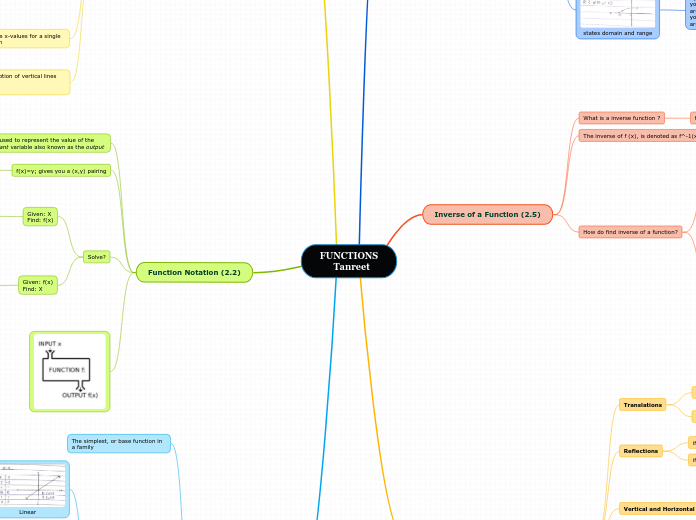FUNCTIONS
Tanreet
Parent Graphs (2.3)
Parent Functions
Linear Function
Quadratic Function
Square Root Function
Absolute Value Function
Reciprocal Function
Reciprocal
Asymptote: A line that the graph of a relation or function gets close to, but never touches
Absolute Value
Square Root
Quadratic
Linear
The simplest, or base function in a family
Function Notation (2.2)
Solve?
Given: f(x)
Find: X
solve for x
Given: X
Find: f(x)
solve for y
f(x)=y; gives you a (x,y) pairing
Other symbols can be used to name the outputs of functions instead of “f” to fit problem
f(x) is used to represent the value of the dependant variable also known as the output
Read as “f at x” or “f of x”
Relations & Functions (2.1)
Function or Not
Lines: Always a function with the exception of vertical lines Circle: Never a function
Parabola: Always a function
Check X Values: If there are 2 or more x-values for a single y-value, then the graph is not a function
Vertical Line Test: If any vertical line passes through more than one point on the graph of a relation then the relation is NOT a function
not a function
does not pass vertical line test
function
passes vertical line test
Relations vs Functions
Function: A special relation. An ordered pair where for every value of x, there is only one value of y.
Relation: is a set of ordered pairs (x,y)
Using Transformations to Graph Functions
Use this knowledge to graph functions
purple has gone through transformations
Vertical and Horizontal Stretches & Compressions
if k < 1 - horizontal stretch
if k > 1 - horizontal compression
if a < 1 - vertical compression
if a > 1 - vertical stretch
Reflections
if k < 0 - reflection in the y-axis
if a < 0 - reflection in the x-axis
Translations
Horizontal Translations
if the function is y = f(x-d) function shifts right
if the function is y = f(x+d) function shifts left
Vertical Translations
if the function is y= f(x) + c, function shifts up
if the function is y= f(x) - c, function shifts down
Inverse of a Function (2.5)
How do find inverse of a function?
switching x & y and isolating for y
The inverse of f (x), is denoted as f^-1(x)
read as “f inverse at x”
What is a inverse function ?
two functions that “reverse” each other
"x" and "y" are switched
Domain & Range (2.4)
Examples
By looking at the graph you can see all x values are greater than -5 and you can see all y values are great than o
states domain and range
By looking at the graph you can see all x values are less than 3 and you can see all y values are greater than 0
Format for stating the domain and range
Set Notation: a way of writing a set of items or numbers
ex. {XER-X cannot=0}
Range - Dependent Variable (all "y" values")
Domain - Independent Variable (all "x" values)

